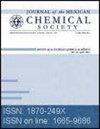了解将 Perezone 转化为 α- 和 β- 哌啶醇的实验事实
IF 0.8
4区 化学
Q3 CHEMISTRY, MULTIDISCIPLINARY
引用次数: 0
摘要
在热条件下,倍半萜醌 perezone 通过分子间环加成反应生成等摩尔量的 a- 和 β-哌唑醇。在 M06-2x/6-311++G(2d,2p) 理论水平上对过渡态和相关反应路径进行的计算证明了实验观察结果的正确性。实验中只观察到外向加合物,这与计算得出的内向加合物和外向加合物相关过渡态之间 6.5 kcal/mol 的能量差相符。活化自由能得到了准确的预测,那些未催化的环加成热过程需要 37.0 kcal/mol。通过对势能面的研究,可以确定在势能面中存在佩列酮的折叠构象。 总结。在热条件下,倍半萜醌类化合物 perezone 通过分子内环加成反应生成等摩尔量的 a-和 β-哌唑。在 M06-2x/6-311++G(2d,2p) 水平上,对过渡态和相关反应路径的计算证明了观察到的结果。实验结果表明,由于相关过渡态的能量相差 6.5 kcal/mol,因此只形成了外向加合物,而没有形成内向加合物。未催化过程的计算活化能为 37.0 kcal/mol。通过对势能面的研究,可以确定 perezone 存在折叠构象。本文章由计算机程序翻译,如有差异,请以英文原文为准。
Understanding Experimental Facts for the Transformation of Perezone into α- and β-pipitzols
Under thermal conditions perezone, a sesquiterpene quinone, forms an equimolar amount of a- and β-pipitzol through an intermolecular cycloaddition reaction. Computational calculations at M06-2x/6-311++G(2d,2p) level of theory of the transition states and the associated reaction paths allow justifying the experimental observations. Only exo adducts are observed experimentally, which is in line with the calculated energy difference of 6.5 kcal/mol between the transition states associated with the endo and exo adducts. Activation free energy was accurately predicted, those the uncatalyzed thermal process of cycloaddition requires 37.0 kcal/mol. The study of the potential energy surface allows to establish the existence of folded conformers of perezone in the potential energy surface. Resumen. En condiciones térmicas la perezona, una quinona sesquiterpénica, forma, cantidades equimolares de a- y β-pipitzoles a través de una reacción de cicloadición intramolecular. A nivel M06-2x/6-311++G(2d,2p) el cálculo de los estados de transición y de las trayectorias de reacción asociadas permiten justificar los resultados observados. Desde el punto de vista experimental sólo se forman los aductos exo y no los endo pues los estados de transición relacionados muestran una diferencia energética de 6.5 kcal/mol. La energía de activación calculada para el procedo desprovisto de catálisis es de 37.0 kcal/mol. El estudio de la superficie de energía potencial permite establecer la existencia de confórmeros plegados de la perezona.
求助全文
通过发布文献求助,成功后即可免费获取论文全文。
去求助
来源期刊
CiteScore
2.00
自引率
0.00%
发文量
0
审稿时长
6-12 weeks
期刊介绍:
The Journal of the Mexican Chemical Society (J. Mex. Chem. Soc.) is a scientific, blind, peer reviewed, and open access, free of charge publication that covers all areas of chemistry and its sub-disciplines (i.e. medicinal chemistry, natural products, electrochemistry, material science, computational chemistry, organic chemistry, bionirganic chemistry, etc). It is devoted to facilitating the worldwide advancement of our understanding of chemistry. It will primarily publish original contributions of research in all branches of the theory and practice of chemistry in its broadest context as well as critical reviews in active areas of chemical research where the author has published significant contribution. The J. Mex. Chem. Soc. is a quarterly publication which language of submission and publication is English. To be suitable for publication in J. Mex. Chem. Soc., manuscripts must describe novel aspects of chemistry, high quality of results and discussion an excellent bibliographic support, and contribute to the development of the field. Routine or incremental work are not suitable for publication in J. Mex. Chem. Soc. Authors are encouraged to send contributions in electronic form. Our online submission system guides you stepwise through the process of entering your article details and uploading your files.

 求助内容:
求助内容: 应助结果提醒方式:
应助结果提醒方式:


